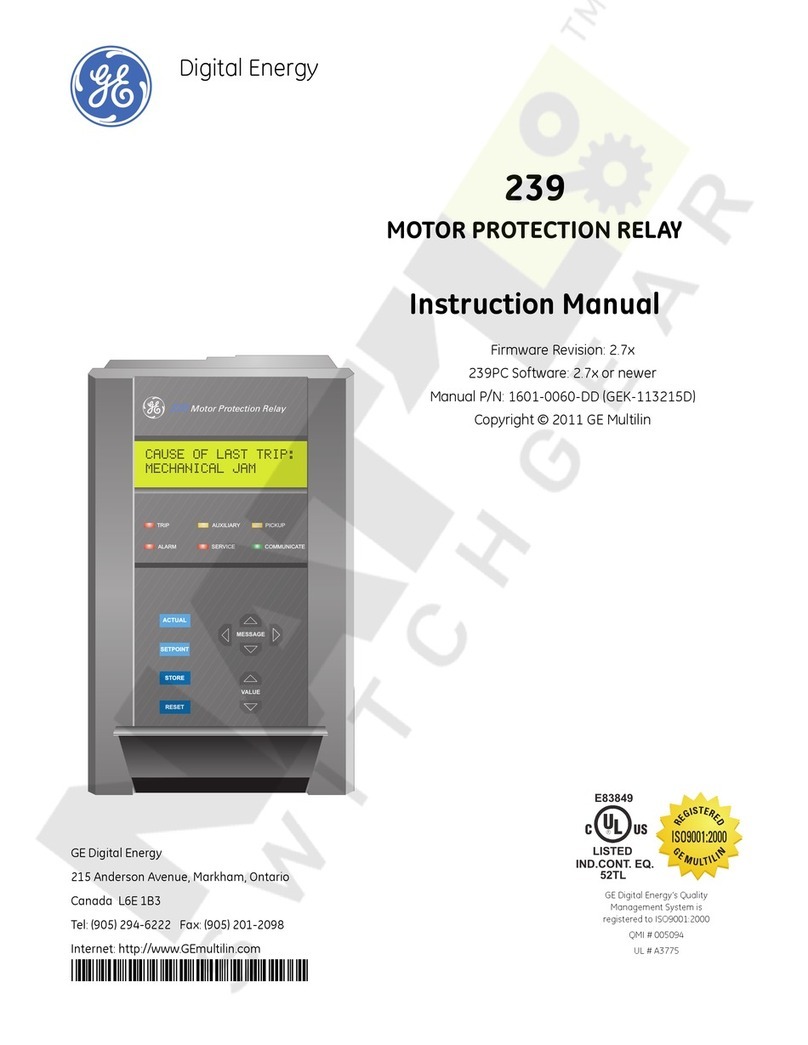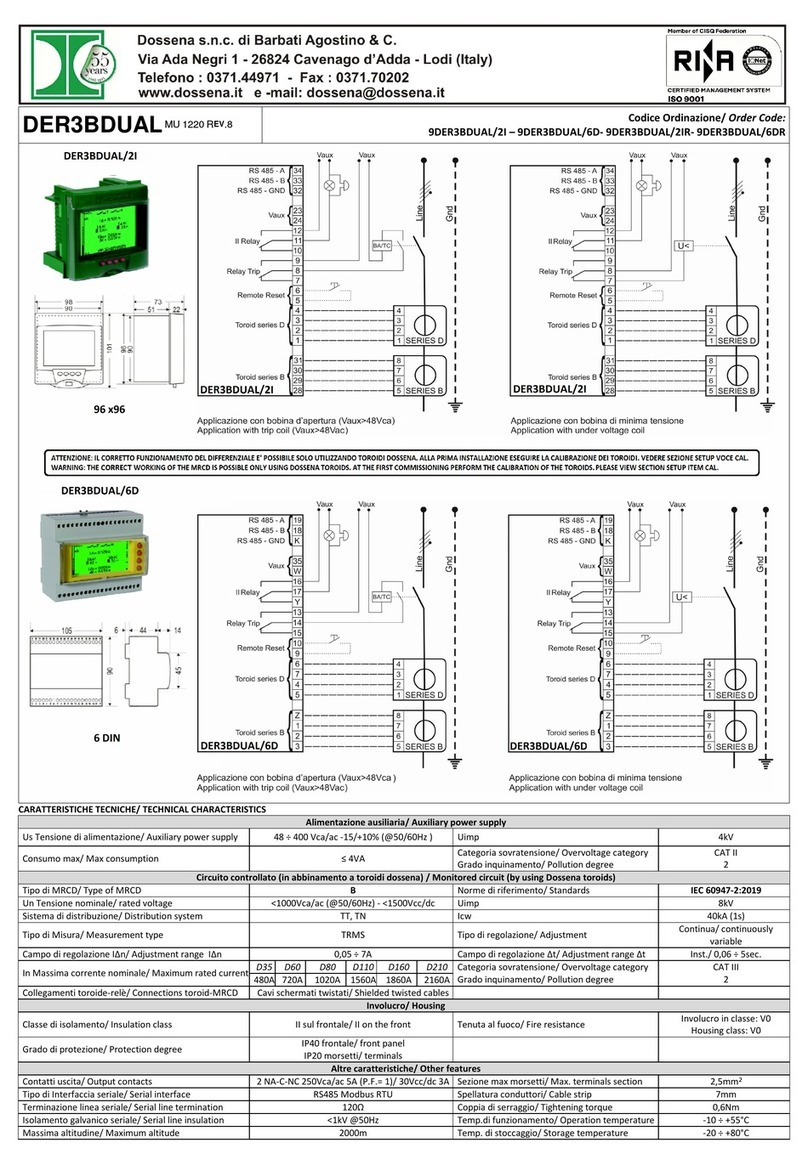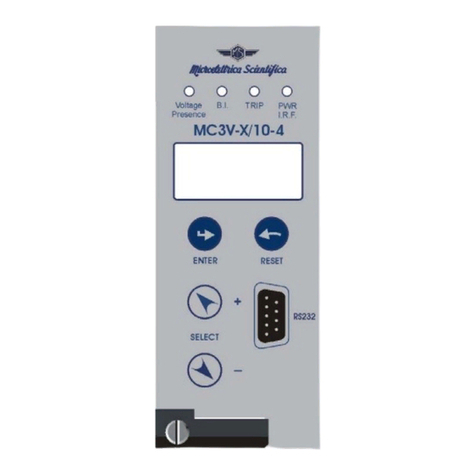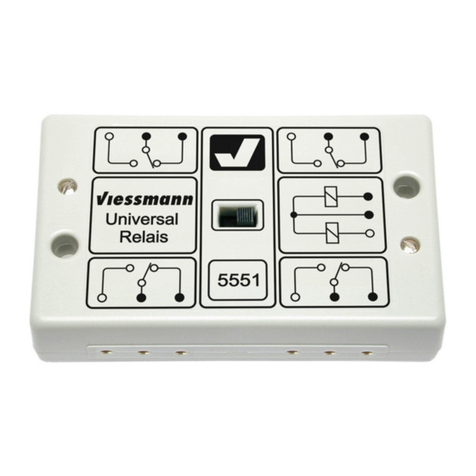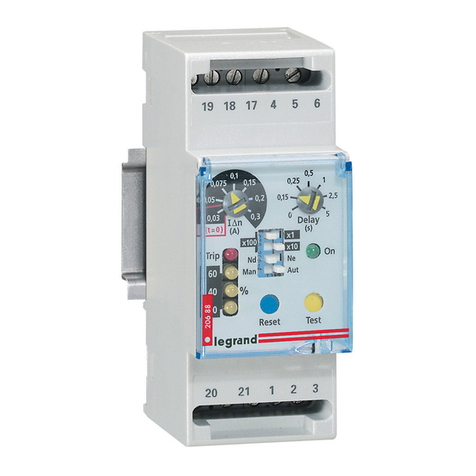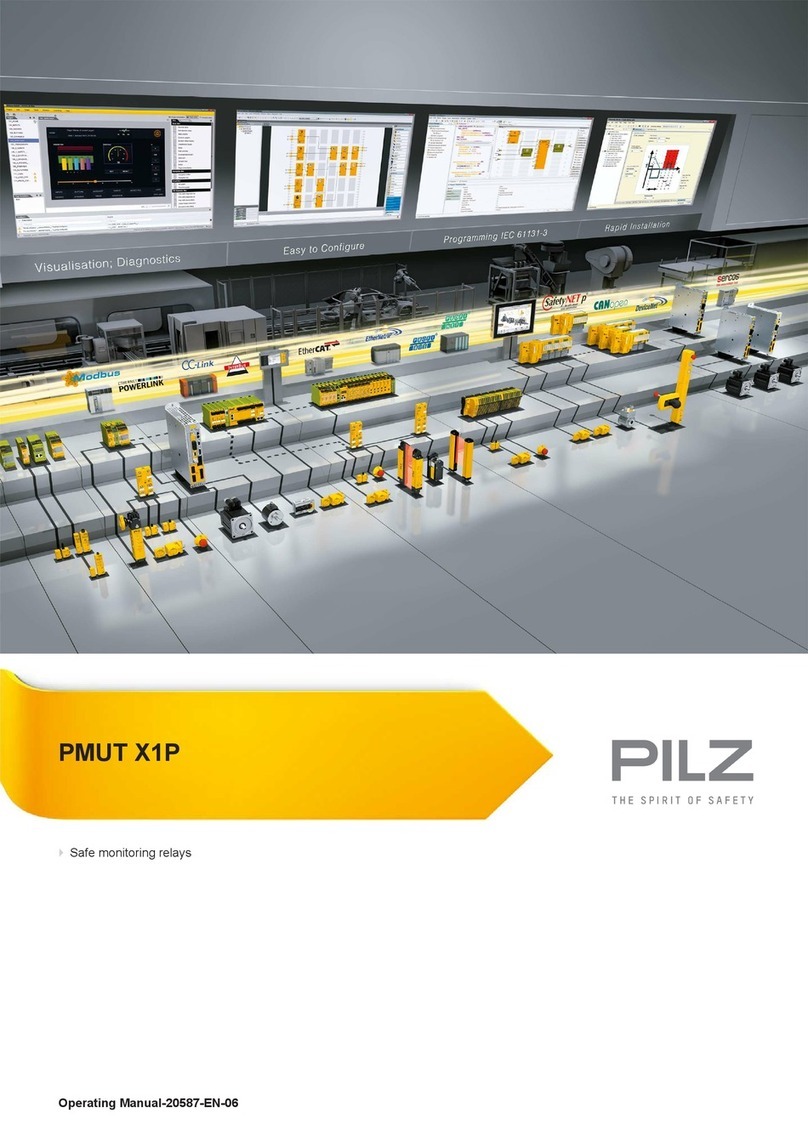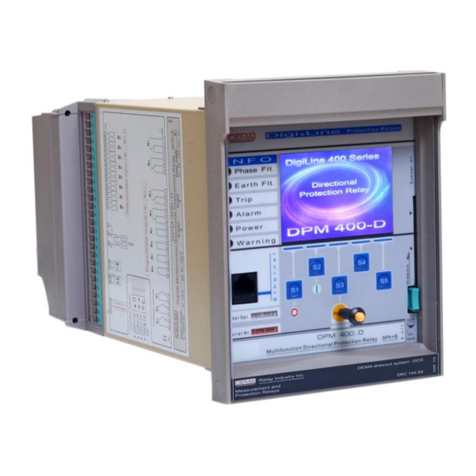GE Digital Energy 735 User manual

Digtital Energy
Multilin
735 / 737 Feeder Protection
Relay
Instruction Manual
Software Revision: 25D156D1.000
Manual P/N: 1601-0048-DK (GEK-106291F)
Copyright © 2010 GE Multilin
GE Multilin
215 Anderson Avenue, Markham, Ontario
Canada L6E 1B3
Tel: (905) 294-6222 Fax: (905) 201-2098
Internet: http://www.GEmultilin.com
*1601-0048-DK*
LISTED
52TL
IND.CONT. EQ.
E83849
IISO9001:2000
G
E
M
U
L
T
I
L
I
N
R
E
G
I
S
T
E
R
E
D
GE Multilin's Quality
Management System is
registered to ISO9001:2000
QMI # 005094
UL # A3775

These instructions do not purport to cover all details or variations in equipment nor provide for every possible contingency
to be met in connection with installation, operation, or maintenance. Should further information be desired or should
particular problems arise which are not covered sufficiently for the purchaser’s purpose, the matter should be referred to
the General Electric Company.
To the extent required the products described herein meet applicable ANSI, IEEE, and NEMA standards; but no such
assurance is given with respect to local codes and ordinances because they vary greatly.
© 2010 GE Multilin Incorporated. All rights reserved.
735 Feeder Protection Relay, is a registered trademark of GE Multilin Inc.
The contents of this manual are the property of GE Multilin Inc. This documentation is furnished on license and may not be
reproduced in whole or in part without the permission of GE Multilin. The content of this manual is for informational use
only and is subject to change without notice.
Part numbers contained in this manual are subject to change without notice, and should therefore be verified by GE
Multilin before ordering.
Part number: 1601-0048-DK (May 2010)

735/737 FEEDER PROTECTION RELAY – INSTRUCTION MANUAL TOC–I
Table of Contents
1: INTRODUCTION OVERVIEW .......................................................................................................... 1-1
FEATURES ............................................................................................................................. 1-1
PRODUCT DESCRIPTION ...................................................................................................... 1-2
THEORY OF OPERATION ...................................................................................................... 1-3
ORDERING ........................................................................................................... 1-6
ORDER CODES ..................................................................................................................... 1-6
ACCESSORIES ....................................................................................................................... 1-6
SPECIFICATIONS ............................................................................................... 1-7
PROTECTION ......................................................................................................................... 1-7
INPUTS .................................................................................................................................. 1-7
OUTPUTS ...............................................................................................................................1-8
POWER SUPPLY ................................................................................................................... 1-9
MISCELLANEOUS .................................................................................................................. 1-9
2: INSTALLATION MECHANICAL ..................................................................................................... 2-1
MOUNTING ........................................................................................................................... 2-1
PRODUCT IDENTIFICATION .................................................................................................. 2-4
ELECTRICAL ....................................................................................................... 2-6
WIRING ................................................................................................................................. 2-6
CURRENT TRANSFORMERS ................................................................................................. 2-9
OUTPUT RELAYS .................................................................................................................. 2-10
COMMUNICATIONS .............................................................................................................. 2-10
CONTROL POWER ................................................................................................................ 2-14
SYSTEM GROUNDING .......................................................................................................... 2-15
HI-POT TESTING .................................................................................................................. 2-15
3: SETUP AND
OPERATION
FRONT PANEL .................................................................................................... 3-1
DESCRIPTION ........................................................................................................................ 3-1
CONTROLS .......................................................................................................... 3-3
PHASE PICKUP [1] ............................................................................................................... 3-3
PHASE CURVE SHAPE [2] ................................................................................................... 3-3
PHASE TIME MULTIPLIER [3] ............................................................................................. 3-4
PHASE INSTANTANEOUS [4] .............................................................................................. 3-5
GROUND PICKUP [5] .......................................................................................................... 3-5
GROUND CURVE SHAPE [6] .............................................................................................. 3-6
GROUND TIME MULTIPLIER [7] ......................................................................................... 3-7
GROUND INSTANTANEOUS [8] .......................................................................................... 3-7
INDICATORS ....................................................................................................... 3-9
STATUS INDICATORS [9] ..................................................................................................... 3-9
TRIP INDICATORS [10] ........................................................................................................ 3-9
PHASE CURRENT INDICATOR [12] .................................................................................... 3-10
SWITCHES ........................................................................................................... 3-11
COMMUNICATION [11] ....................................................................................................... 3-11
OPTION SWITCHES [14] ..................................................................................................... 3-11
SETUP PROGRAM .............................................................................................. 3-16
DESCRIPTION ........................................................................................................................ 3-16
COMMUNICATE .................................................................................................................... 3-17
SETPOINTS EDITOR .............................................................................................................. 3-17

TOC–II 735/737 FEEDER PROTECTION RELAY – INSTRUCTION MANUAL
SYSTEM CONFIGURATION ................................................................................................... 3-18
STATUS .................................................................................................................................. 3-19
ACTUAL VALUES .................................................................................................................. 3-19
SETPOINTS ............................................................................................................................ 3-20
COMMANDS .......................................................................................................................... 3-20
FILE ........................................................................................................................................ 3-21
SETUP EXAMPLE ............................................................................................... 3-22
EXAMPLE REQUIREMENTS AND SETTINGS ........................................................................ 3-22
4: MODBUS
COMMUNICATIONS
OVERVIEW .......................................................................................................... 4-1
DESCRIPTION ........................................................................................................................ 4-1
ELECTRICAL INTERFACE ....................................................................................................... 4-1
DATA FRAME FORMAT AND RATE ..................................................................................... 4-2
DATA PACKET FORMAT ....................................................................................................... 4-2
TIMING .................................................................................................................................. 4-3
ERROR CHECKING ................................................................................................................ 4-3
SUPPORTED MODBUS FUNCTIONS ............................................................... 4-5
DESCRIPTION ........................................................................................................................ 4-5
FUNCTION CODE 03: READ SETPOINTS ........................................................................... 4-5
FUNCTION CODE 04: READ ACTUAL VALUES ................................................................. 4-6
FUNCTION CODE 05: EXECUTE OPERATION .................................................................... 4-7
FUNCTION CODE 06: STORE SINGLE SETPOINT ............................................................. 4-8
FUNCTION CODE 07: READ STATUS ................................................................................ 4-9
FUNCTION CODE 16: STORE MULTIPLE SETPOINTS ....................................................... 4-9
ERROR RESPONSES .............................................................................................................. 4-12
MEMORY MAP .................................................................................................... 4-13
MODBUS MEMORY MAP ..................................................................................................... 4-13
MEMORY MAP DATA FORMATS ......................................................................................... 4-16
5: OVERCURRENT
CURVES
OVERVIEW .......................................................................................................... 5-1
DESCRIPTION ........................................................................................................................ 5-1
ANSI CURVES ..................................................................................................... 5-3
ANSI MODERATELY INVERSE CURVES ............................................................................. 5-3
ANSI NORMAL INVERSE CURVES ..................................................................................... 5-6
ANSI VERY INVERSE CURVES ............................................................................................ 5-9
ANSI EXTREMELY INVERSE CURVES ................................................................................. 5-12
DEFINITE TIME CURVES .................................................................................. 5-15
DESCRIPTION ........................................................................................................................ 5-15
IAC CURVES ........................................................................................................ 5-18
IAC SHORT INVERSE CURVES ............................................................................................ 5-18
IAC INVERSE CURVES ......................................................................................................... 5-21
IAC VERY INVERSE CURVES ............................................................................................... 5-24
IAC EXTREMELY INVERSE CURVES .................................................................................... 5-27
IEC CURVES ........................................................................................................ 5-30
IEC SHORT TIME CURVES .................................................................................................. 5-30
IEC A CURVES ..................................................................................................................... 5-33
IEC B CURVES ..................................................................................................................... 5-36
IEC C CURVES ..................................................................................................................... 5-39

735/737 FEEDER PROTECTION RELAY – INSTRUCTION MANUAL TOC–III
6: TESTING PROCEDURES ..................................................................................................... 6-1
PRIMARY INJECTION TESTING ............................................................................................ 6-1
SECONDARY INJECTION TESTING ...................................................................................... 6-1
COMMUNICATIONS TEST .................................................................................................... 6-1
PHASE CURRENT READING ACCURACY TEST .................................................................. 6-2
GROUND CURRENT READING ACCURACY TEST .............................................................. 6-2
INSTANTANEOUS PHASE OVERCURRENT PICKUP LEVEL TEST ...................................... 6-2
INSTANTANEOUS GROUND FAULT OVERCURRENT PICKUP LEVEL TEST ...................... 6-2
INSTANTANEOUS PHASE OVERCURRENT TIMING TEST .................................................. 6-3
INSTANTANEOUS GROUND FAULT OVERCURRENT TIMING TEST .................................. 6-4
PHASE OVERCURRENT CURVE VERIFICATION .................................................................. 6-4
GROUND FAULT OVERCURRENT CURVE VERIFICATION ................................................. 6-4
POWER LOSS/RECOVER TEST ............................................................................................ 6-4
HIPOTENTIAL TEST ............................................................................................................. 6-5
TEST RECORDS .................................................................................................. 6-6
735/737 TEST RECORD .................................................................................................... 6-6
COMMUNICATIONS TEST .................................................................................................... 6-6
PHASE CURRENT READING ACCURACY TEST .................................................................. 6-6
GROUND CURRENT READING ACCURACY TEST .............................................................. 6-7
INSTANTANEOUS PHASE OVERCURRENT PICKUP TEST .................................................. 6-7
INSTANTANEOUS GROUND OVERCURRENT PICKUP TEST .............................................. 6-7
INSTANTANEOUS PHASE OVERCURRENT TIMING TEST .................................................. 6-8
INSTANTANEOUS GROUND FAULT OVERCURRENT TIMING TEST .................................. 6-8
PHASE OVERCURRENT CURVE VERIFICATION .................................................................. 6-8
GROUND FAULT OVERCURRENT CURVE VERIFICATION ................................................. 6-9
POWER FAIL/RECOVER TEST .............................................................................................. 6-9
HIPOTENTIAL TEST ............................................................................................................. 6-9
7: COMMISSIONING SETTINGS TABLE .............................................................................................. 7-1
INSTALLATION INFORMATION ............................................................................................. 7-1
RELAY SETTINGS .................................................................................................................. 7-1
APPENDIX OVERCURRENT PROTECTION SAMPLE CALCULATIONS ....................... A-1
CHARACTERISTICS ................................................................................................................ A-1
PHASE TIMED O/C PICKUP ................................................................................................ A-1
PHASE INSTANTANEOUS PICKUP ....................................................................................... A-2
GROUND PICKUP ................................................................................................................. A-2
GROUND INSTANTANEOUS ................................................................................................. A-2
FEEDER DEDICATED TO A TRANSFORMER ............................................... A-3
CHARACTERISTICS ................................................................................................................ A-3
PHASE TIMED O/C PICKUP ................................................................................................ A-3
PHASE INSTANTANEOUS ..................................................................................................... A-3
DOS AND DON’TS .............................................................................................. A-4
CHECKLIST ............................................................................................................................ A-4
REVISION HISTORY .......................................................................................... A-6
CHANGE NOTES ................................................................................................................... A-6
CHANGES TO THE MANUAL ............................................................................................... A-6
WARRANTY INFORMATION ........................................................................... A-8
WARRANTY ........................................................................................................................... A-8

TOC–IV 735/737 FEEDER PROTECTION RELAY – INSTRUCTION MANUAL

735/737 FEEDER PROTECTION RELAY – INSTRUCTION MANUAL 1–1
735/737 Feeder Protection Relay
Chapter 1: Introduction
Digital Energy
Multilin
803649A2.CDR
STATUSTRIP
PHASE
GROUND
COMMUNICATION CURRENT
RELAY IN
SERVICE
SERVICE
REQUIRED
PHASE
PICKUP
GROUND
PICKUP
PICKUP
(% OFCT)
150
150
60
60
6
4
1
10
9
8
3
2
7
5
6
4
1
10
9
8
3
2
7
5
10
10
6
6
OFF
OFF
20
20
16
16
14
14
5
5
4
4
12
12
8
8
OFF
OFF
OFF
OFF
130
130
40
40
200
200
90
90
140
140
50
50
220
220
100
100
180
180
80
80
120
120
30
30
160
160
70
70
110
110
20
20
PICKUP
(% OFCT)
CURVESHAPE
M
O
D
ER
AT
E
LY
IN
V
ER
S
E
E
XT
RE
M
EL
YI
N
VE
RS
E
V
E
RY
IN
V
ER
S
E
DE
FI
NIT
E
TI
M
E
NO
R
M
AL
IN
VE
R
SE
M
O
D
ER
AT
E
LY
IN
V
ER
S
E
E
XT
RE
M
EL
YI
N
VE
RS
E
V
E
RY
IN
V
ER
S
E
DE
FI
NIT
E
TI
M
E
NO
R
M
AL
IN
VE
R
SE
CURVESHAPE
TIMEMULTIPLIER
TIMEMULTIPLIER
INSTANTANEOUS
(x CT)
INSTANTANEOUS
(x CT)
TIME51INST 50
A
1
2
3
4
5
6
7
8
+1
+2
+4
+8
+16
100%
90%
80%
70%
60%
50%
40%
30%
20%
10%
B
C
G
CLEAR
(% OFCT)
BAUD
ADDRESS
TEST
19200
9600
2400
1200
LO
LO
LO
LO
LO
HI
HI
HI
HI
HI
LO
LO
LO
LO
HI
HI
HI
HI
LO
HI
737 Feeder Protection Relay
Introduction
1.1 Overview
1.1.1 Features
Protection
• 3 separate phase time overcurrent (51) elements with 5 curve shapes:
Definite time, moderately inverse, normal inverse, very inverse, extremely inverse.
• Phase instantaneous (50) element
• Ground time overcurrent (51G) with 5 curve shapes:
• Definite time, moderately inverse, normal inverse, very inverse, extremely inverse.
• Ground instantaneous (50G) element
• 10 curves for each shape
• 4 time multipliers for each curve
• 3 different curve types: ANSI, IAC, IEC/BS142
Indicators
Trip:
Phase A, B, C instantaneous
Phase A, B, C time overcurrent
Ground fault instantaneous
Ground fault time overcurrent
Status:
Relay in service
Service required
Phase pickup
Ground pickup

1–2 735/737 FEEDER PROTECTION RELAY – INSTRUCTION MANUAL
CHAPTER 1: INTRODUCTION
Current bargraph: 10 to 100%
Other
• Conventional 1 A or 5 A CT input
•Drawoutcase
• AC or DC control power
• Seal provision for tamper proof settings
• Output contacts:
•Trip
•AuxTrip
•ServiceRequired
•(737 only) pickup, trip, cause of trip outputs;
• 50A, 50B, 50C, 50N
• 51A, 51B, 51C, 51N
• RS485 communications: settings, currents, status
• 86 lockout
• Programmable block instantaneous on autoreclose.
• Ground Fault trip programmable to Aux. Trip relay, separate from Main trip.
1.1.2 Product Description
The 735/737 is a microprocessor based relay used to perform primary circuit protection on
distribution networks at any voltage level. Instantaneous and time overcurrent phase and
ground protection features replace the equivalent of 8 separate protection devices. Each
protection element can be selectively enabled by front panel dial settings. Flexible settings
and selectable curve shapes enable accurate coordination with other devices. Cause of
trip indications and a bar graph load monitor are provided on the front panel.
A momentary dry contact closure from the 735/737 relay is used to activate the breaker
trip coil in the event of a fault. To help determine the cause of a trip, separate indicators
are provided for phase instantaneous, phase time overcurrent, ground fault
instantaneous, and ground fault time overcurrent. These latched indicators remain set
after a breaker trip. They can be reset by the front panel CLEAR button.
A special feature of the 735/737 named "Trip Record" is the ability of the relay to
sequentially display the last five causes of trips. To display the trips, press and hold the
reset key. After 2 seconds, the front panel indicators will display the last 5 trips starting
with the most recent.
The 735/737 has separately adjustable instantaneous and time overcurrent pickup levels.
No intentional delay is added to the instantaneous trip. Five separate time overcurrent
curve shapes can be selected: definite time, moderately inverse, normal inverse, very
inverse, and extremely inverse. For each curve shape, 40 different curves to produce
different time delay levels can be selected using the time multiplier settings and curve
shift. These allow selection of optimum coordination with fuses, feeders, motors, trans-

CHAPTER 1: INTRODUCTION
735/737 FEEDER PROTECTION RELAY – INSTRUCTION MANUAL 1–3
formers, etc. To monitor load current, a front panel bar graph indicator is provided. It gives
an indication of 10% of CT rating to 100% of CT in steps of 10%. This is useful for
monitoring breaker loading and during testing.
Ground level and time delay can be selected for coordination with upstream devices. The
ground signal is normally derived as the residual sum of the 3 phase CTs, eliminating the
need for an additional ground sensor. Alternatively, for more sensitive detection, an
additional core balance (zero sequence) ground sensor, encircling the 3 phase conductors,
can be used. Like time overcurrent phase protection, 5 separate curve shapes and 40
curves for each shape are available for ground fault protection.
To accommodate more complex control schemes the 737 has 8 additional output relays to
provide a separate dry contact output for each different protection element. That is, in
addition to the 2 common trip contacts, the 737 has contacts for trip from:
51A, 51B, 51C, 51N, 50A, 50B, 50C, and 50N
These eight additional outputs can be programmed to activate:
• as a separate trip output for each 50/51 protection element
• as a latched cause of trip output for fault diagnosis interface to a SCADA
• when phase/ground current exceeds the pickup setting to warn of an impending
trip
Internal monitoring of the relay is continuous. When control power is applied and the relay
is operating normally, the "RELAY IN SERVICE" LED is on. Should a fault be detected, the
"SERVICE REQUIRED" LED will light to indicate a problem. In addition, the failsafe SERVICE
relay output will change state signalling a malfunction to a remote monitoring device such
as a programmable controller. In this case the 735/737 relay should be replaced and sent
in for service. As long as the "SERVICE" LED is off and the "RELAY IN SERVICE" LED is on the
relay is operating normally. If the test switch is on, the RELAY IN SERVICE LED will flash.
When either the phase or ground time/overcurrent threshold is exceeded, a separate
pickup indicator flashes which is useful for testing, and to warn of an impending trip.
Relay states can be monitored via the RS485 communication port. This allows relays to be
linked together over a simple twisted pair wire to communicate with a PLC or computer
using the Modbus protocol. Baud rate and a unique slave address are set via the front
panel communications switches.
1.1.3 Theory of Operation
A block diagram of the 735/737 hardware is shown on the following page. A 16-bit single
chip microcomputer handles data acquisition, input/output and control. Program memory,
data RAM, 10 bit A/D and UART are internal to the microcomputer.
Phase and ground current are monitored via external CTs which are connected to internal
interposing CTs for isolation and signal conditioning. Low pass filters, level shifters and
gain amplifiers transform the input signal to a level suitable for conversion by the 10 bit A/
D. A/D values are converted, using software, to the true RMS value of the input sinewave.
Separate ×1 and ×10 gain amplifiers are continuously sampled by the A/D convertor with
program logic dynamically choosing the appropriate range.

1–4 735/737 FEEDER PROTECTION RELAY – INSTRUCTION MANUAL
CHAPTER 1: INTRODUCTION
Eight rotary switches and 2 banks of DIP switches are periodically read and decoded to
determine settings. Using the appropriate curve settings, the microcomputer computes
instantaneous and time overcurrent values closing the trip relay when a trip value is
reached. This relay will remain latched until all phase and ground currents have dropped to
zero. True RMS current is calculated and bar graph segments are driven under program
control to indicate the value. All output relays are driven in response to computed
conditions. These drivers are opto-isolated and a separate relay supply is used to prevent
noise coupling for external sources to the microcomputer.
To prevent possible lockup of the relay in case of abnormal transient conditions, a separate
hardware timer is continuously reset by the microcomputer under normal conditions. In
the event of the program hanging up, this external watchdog will time out and issue a
system reset.
An internal UART buffered by an isolated RS485 driver controls the serial communications.
Baud rate is selectable through an internal timer. Like all other inputs/outputs transient
protection is applied to ensure reliable operation under real conditions.
A flyback switching power supply generates multiple isolated supply voltages of +12 I/O,
+5 digital, +12 analog and +5 RS485. Two different versions are available to cover the
range 20 to 60 V DC or 90 to 300 V DC. Front end rectification and filtering enable these
supplies to also be used with 50/60Hz control power sources.
Structured firmware design running under a real time operating kernel ensures robust
program operation under different conditions. It also contributes to bug free code
maintenance.

CHAPTER 1: INTRODUCTION
735/737 FEEDER PROTECTION RELAY – INSTRUCTION MANUAL 1–5
FIGURE 1–1: 735 Block Diagram

1–6 735/737 FEEDER PROTECTION RELAY – INSTRUCTION MANUAL
CHAPTER 1: INTRODUCTION
1.2 Ordering
1.2.1 Order Codes
The CT secondary must be specified with an order as 1 or 5 amps. The RS485
communications interface is available with RS422 as an option. For 19" rack mount
applications, single and dual cutout panels for mounting one or two relays are available.
These are 3 units high (10.5") for 19-inch rack mounting, made of 14 gauge steel and come
in ASA 61 gray. See Section 2.1.1: Mounting for dimensions of the relay and panels. For
bench testing, the 735/737 can be ordered mounted in a portable case.
The GE Multilin order code is as follows:
1.2.2 Accessories
The following additional accessories are available:
• 19-1 PANEL: Single cutout panel
• 19-2 PANEL: Dual cutout panel
• SCI: RS232 to RS485 convertor
• 3" Collar: SR series collar 1009-0055
• 1 " Collar: SR series collar 1009-0047
• Optional Mounting Kit: 1819-0030
Table 1–1: Order Codes
735
737
–
–
S
S
–
–
S
S
–
–
S
S
–
–
S
S
Basic Unit 735
737 |
||
||
||
|Standard 735 Relay with 50/51, 50G/51G protection
737 Relay (same as 735 with 8 additional output relays)
Phase CT
Secondary
1||| 1 A Phase CT secondaries
5||| 5 A Phase CT secondaries
Ground CT
Secondary
1 | | 1 A Ground CT secondaries
5 | | 5 A Ground CT secondaries
Control Power LO | 20 to 60 V DC; 20 to 48 V AC at 50/60 Hz
HI | 90 to 300 V DC; 70 to 265 V AC at 50/60 Hz
Options 485 RS485 2-wire communications (standard)
422 RS422 4-wire communications (optional)
DEMO 735 Demo/Test case
3
8
---

CHAPTER 1: INTRODUCTION
735/737 FEEDER PROTECTION RELAY – INSTRUCTION MANUAL 1–7
1.3 Specifications
1.3.1 Protection
PHASE TIME OVERCURRENT (51)
Pickup level: ......................................................LO: 20 to 100% of CT rating or OFF
HI: 110 to 220% of CT rating or OFF
Curve Types: .....................................................ANSI, IAC, IEC/BS142
Curve shapes: ..................................................definite time, moderately inverse, normal, inverse, very
inverse, extremely inverse.
See time/overcurrent curves; curves apply up to 20 x
pickup or 20 x CT, whichever is less.
Time multiplier: ...............................................10 curves: #1 to #10 for each shape
4 shift multipliers: 0.5, 0.8, 1, 1.1
Definite time:....................................................100 ms to 1 sec. in steps of 100 ms.
Reset:....................................................................Time reset to zero each time current level falls below
pickup threshold
Accuracy: ..........................................................Level: ±3% of setting
Time: greater of ±3% or ±20ms at >150% of pickup
PHASE INSTANTANEOUS OVERCURRENT (50)
Pickup level: ......................................................4, 5, 6, 8, 10, 12, 14, 16, 20 ×CT or OFF
Accuracy: ...........................................................Level: ±3% of setting
Time: 35ms maximum at >150% of pickup setting
GROUND TIME OVERCURRENT (51G/51N)
Pickup level: ......................................................LO: 15 to 55% of CT rating in steps of 5% or OFF
HI: 60 to 100% of CT rating in steps of 5% or OFF
Curve Types: .....................................................ANSI, IAC, IEC/BS142
Curve shapes: ..................................................definite time, moderately inverse, normal, inverse, very
inverse, extremely inverse.
See time/overcurrent curves; curves apply up to 20 ×
pickup or 20 ×sensor, whichever is less.
Time multiplier: ...............................................10 curves: #1 to #10 for each shape
4 shift multipliers: 0.5, 0.8, 1, 1.1
Definite time:....................................................100 ms to 1 sec. in steps of 100 ms
Reset:....................................................................Time reset to zero each time current level falls below
pickup
Accuracy: ..........................................................Level: ±3% of setting
Time: greater of ±3% or ±20ms at >150% of pickup
GROUND INSTANTANEOUS OVERCURRENT (50G/50N)
Pickup level: ......................................................0.1, 0.2, 0.4, 0.8, 1, 2, 4, 8, 16, ×CT or OFF
Accuracy: ...........................................................Level: ±3% of setting
Time: 35ms maximum at >150% of pickup setting
1.3.2 Inputs
CURRENT INPUTS
Withstand Phase/Ground CTs:.................4 times rated current: continuous
20 times rated current: 5 second
40 times rated current: 2 second
Sensing:...............................................................True RMS; 16 samples/cycle

1–8 735/737 FEEDER PROTECTION RELAY – INSTRUCTION MANUAL
CHAPTER 1: INTRODUCTION
Secondary:.........................................................1 A or 5 A (must be specified with order)
Accuracy:............................................................greater of 3% of CT primary or 3% of displayed
Drift: ......................................................................No greater than 0.5% over 10 years
CT BURDEN
1 Amp inputs: ...................................................0.02 VA at 1 A; 0.2 VA at 5 A; 10 VA at 20 A
5 Amp inputs: ...................................................0.02 VA at 5 A; 0.2 VA at 20 A; 10 VA at 100 A
Conversion range:..........................................0 to 20 times CT primary
Frequency response: ....................................48 to 300 Hz ± 3 dB
1.3.3 Outputs
TRIP, AUX TRIP OUTPUT RELAYS
Configuration:..................................................Form A NO
Contact Material:............................................Silver Alloy
SERVICE, PICKUP/CAUSE OF TRIP OUTPUT RELAYS
Table 1–2:
VOLTAGE MAKE/CARRY BREAK MAX
LOAD
CONTINUOU
S
0.2 S
DC Resistive
30 V DC 20 A 80 A 16 A 480 W
125 V DC 20 A 80 A 0.8 A 100 W
250 V DC 20 A 80 A 0.4 A 100 W
DC Inductive,
L/R = 40 mS
30 V DC 20 A 80 A 5 A 150 W
125 V DC 20 A 80 A 0.3 A 375 W
250 V DC 20 A 80 A 0.2 A 50 W
AC Resistive
120 V AC 20 A 80 A 20 A 2400 VA
250 V AC 20 A 80 A 20 A 5000 VA
AC Inductive
PF = 0.4
120 V AC 20 A 80 A 8 A 960 VA
250 V AC 20 A 80 A 7 A 1750 VA
Table 1–3:
VOLTAGE MAKE/CARRY BREAK MAX
LOAD
CONTINUOU
S
0.2 S
DC Resistive
30 V DC 10 A 30 A 10 A 300 W
125 V DC 10 A 30 A 0.5 A 62.5 W
250 V DC 10 A 30 A 0.3 A 75 W
DC Inductive,
L/R = 40 mS
30 V DC 10 A 30 A 5 A 150 W
125 V DC 10 A 30 A 0.25 A 31.3 W
250 V DC 10 A 30 A 0.15 A 37.5 W

CHAPTER 1: INTRODUCTION
735/737 FEEDER PROTECTION RELAY – INSTRUCTION MANUAL 1–9
Configuration:..................................................Form C NO/NC
Contact Material:............................................Silver Alloy
1.3.4 Power Supply
CONTROL POWER
DC supply:..........................................................HI: 125 V DC, 250 V DC nominal
LO: 48 V DC nominal
Range:..................................................................HI: 90 to 300 VDC, 70 to 265 V AC
LO: 20 to 60 V DC, 20 to 48 V AC
Power:..................................................................nominal 10W, maximum 25W
1.3.5 Miscellaneous
INDICATORS
Phase time overcurrent trip A,B,C (latched)
Phase instantaneous overcurrent trip A,B,C (latched)
Ground fault time overcurrent trip (latched)
Ground fault instantaneous overcurrent trip (latched)
Relay in service
Service required
Phase pickup
Ground pickup
Current level LED bargraph:......................10-100%
ENVIRONMENT
Operating temperature range: ...............–40°C to +70°C
Ambient storage temperature: ...............–40°C to +80°C
Humidity:............................................................up to 90%, non-condensing.
LONG-TERM STORAGE
Environment: ....................................................In addition to the above environmental considerations,
the relay should be stored in an environment that is dry,
corrosive-free, and not in direct sunlight.
Correct storage:..............................................Prevents premature component failures caused by
environmental factors such as moisture or corrosive
gases. Exposure to high humidity or corrosive
environments will prematurely degrade the electronic
components in any electronic device regardless of its use
or manufacturer, unless specific precautions, such as
those mentioned in the Environment section above, are
taken.
AC Resistive
120 V AC 10 A 30 A 10 A 2770 VA
250 V AC 10 A 30 A 10 A 2770 VA
AC Inductive
PF = 0.4
120 V AC 10 A 30 A 4 A 480 VA
250 V AC 10 A 30 A 3 A 750 VA
Table 1–3:
VOLTAGE MAKE/CARRY BREAK MAX
LOAD
CONTINUOU
S
0.2 S

1–10 735/737 FEEDER PROTECTION RELAY – INSTRUCTION MANUAL
CHAPTER 1: INTRODUCTION
Note It is recommended that 735 relays be powered up once per year, for one hour
continuously, to avoid deterioration of electrolytic capacitors and subsequent relay
failure.
TYPE TESTING
Insulation Resistance: ..................................per IEC 255-5 (500 V DC, 2000 MΩ)
Dielectric Strength: ........................................per IEC 255-5 and ANSI/IEEE C37.90 (2 kV at 60 Hz for 1
minute)
Impulse Voltage ..............................................per IEC 255-5 (5 kV)
Surge Immunity:..............................................per EN 61000-4-5 (common mode 4 kV, differential
modes 2 kV)
Oscillatory Surge Withstand: ....................per ANSI/IEEE C37.90.1, per Ontario Hydro A-28M-82
Voltage Dips......................................................per IEC 61000-4-11 (0%, 40%, 70%)
Electrostatic Discharge:...............................per IEC 255-22-2 (4/4 kV)
Damp Heat (Humidity Cyclic):...................per IEC 68-2-30 (6 days)
Make and Carry for relays:.........................per IEEE C37.90 (30 A)
Current Withstand: ........................................per ANSI/IEEE C37.90 (40 ×rated 1 A for 2 seconds; 60 ×
rated 5 A for 1 second)
RFI Radiated Immunity:...............................per IEC 255-22-3 (160 MHz, 460 MHz), per EN 61000-4-3
(10 V/m)
RFI Conducted Immunity:...........................per EN-61000-4-6 (10 V)
Temperature Cycle: .......................................–40°C, +60°C (per GE internal procedures)
Mechanical Stress:.........................................2 g (per GE internal procedures)
Current Calibration:.......................................per GE internal procedures
10 A DC continuous relay current carry at 80°C per GE internal procedures
PRODUCTION TESTS
Dielectric Strength: ........................................1.9 kV AC for 1 second or 1.6 kV AC for 1 minute, per UL
508.
DO NOT CONNECT FILTER GROUND TO SAFETY GROUND DURING ANY PRODUCTION TESTS!

735/737 FEEDER PROTECTION RELAY – INSTRUCTION MANUAL 2–1
735/737 Feeder Protection Relay
Chapter 2: Installation
Digital Energy
Multilin
803649A2.CDR
STATUSTRIP
PHASE
GROUND
COMMUNICATION CURRENT
RELAY IN
SERVICE
SERVICE
REQUIRED
PHASE
PICKUP
GROUND
PICKUP
PICKUP
(% OFCT)
150
150
60
60
6
4
1
10
9
8
3
2
7
5
6
4
1
10
9
8
3
2
7
5
10
10
6
6
OFF
OFF
20
20
16
16
14
14
5
5
4
4
12
12
8
8
OFF
OFF
OFF
OFF
130
130
40
40
200
200
90
90
140
140
50
50
220
220
100
100
180
180
80
80
120
120
30
30
160
160
70
70
110
110
20
20
PICKUP
(% OFCT)
CURVESHAPE
M
O
D
ER
AT
E
LY
IN
V
ER
S
E
E
XT
RE
M
EL
YI
N
VE
RS
E
V
E
RY
IN
V
ER
S
E
DE
FI
NIT
E
TI
M
E
NO
R
M
AL
IN
VE
R
SE
M
O
D
ER
AT
E
LY
IN
V
ER
S
E
E
XT
RE
M
EL
YI
N
VE
RS
E
V
E
RY
IN
V
ER
S
E
DE
FI
NIT
E
TI
M
E
NO
R
M
AL
IN
VE
R
SE
CURVESHAPE
TIMEMULTIPLIER
TIMEMULTIPLIER
INSTANTANEOUS
(x CT)
INSTANTANEOUS
(x CT)
TIME51INST 50
A
1
2
3
4
5
6
7
8
+1
+2
+4
+8
+16
100%
90%
80%
70%
60%
50%
40%
30%
20%
10%
B
C
G
CLEAR
(% OFCT)
BAUD
ADDRESS
TEST
19200
9600
2400
1200
LO
LO
LO
LO
LO
HI
HI
HI
HI
HI
LO
LO
LO
LO
HI
HI
HI
HI
LO
HI
737 Feeder Protection Relay
Instal latio n
2.1 Mechanical
2.1.1 Mounting
The 735 is a drawout relay that slides into the panel mounted case. A hinged door covers
the front panel controls to allow protected access of the setting selector switches. This
allows pickup levels and time delays to be quickly set or modified. The figure below shows
the physical dimensions of the 735/737. A single cutout in the panel, as per the dimensions
of FIGURE 2–2: Single and Double Unit Panel Cutouts is required to mount the fixed chassis.
When mounting the 735, provision should be made for the door to open without hitting
adjacent components mounted on the panel. For 19-inch rack mount applications, a 735
can be mounted individually on a panel or side-by-side with another SR series relay (such
as the 760) for backup applications. Details are shown below.

2–2 735/737 FEEDER PROTECTION RELAY – INSTRUCTION MANUAL
CHAPTER 2: INSTALLATION
FIGURE 2–1: Dimensions
FIGURE 2–2: Single and Double Unit Panel Cutouts
Remove the relay from the case during mounting (see the following section). Slide the case
into the cutout from the front of the panel as shown below. While firmly applying pressure
from the front of the chassis to ensure the front bezel fits snugly, bend out the retaining
tabs as shown below.
FIGURE 2–3: Sliding the Unit into the Panel

CHAPTER 2: INSTALLATION
735/737 FEEDER PROTECTION RELAY – INSTRUCTION MANUAL 2–3
FIGURE 2–4: Bend Up Mounting Tabs
The retaining tabs will be sufficient to hold the chassis securely in place. If additional
fastening is desired the SR optional mounting kit can be ordered. This kit provides
additional support with adjustable mounting brackets. The captive chassis should now be
securely mounted to the panel with no movement, ready for rear terminal wiring.
Drawout Relay To remove the relay, open the door by grasping the right side at the top and pulling until
the friction catch releases. There is a locking catch in the center of the handle. With a
screwdriver or your finger placed horizontally in the center, squeeze the catch upwards
until the catch disengages, then pull the handle outward so it rotates up, as shown below.
Firmly grasp the handle and pull upwards to the vertical endstop until the relay completely
disengages.
FIGURE 2–5: Relay Withdrawal
Press latch and pull to
disengage handle
Rotate handle to vertical stop
position and pull to withdraw

2–4 735/737 FEEDER PROTECTION RELAY – INSTRUCTION MANUAL
CHAPTER 2: INSTALLATION
To insert the relay, raise the handle to the highest position. Slide the relay into the case
until the guide pins engage in the slots on each side. Now press downward on the handle
until it clicks and locks in the vertical position. An index pin at the back of the 737 captive
chassis prevents the wrong model of relay from being inserted into a non-matching case.
This will prevent the relay from being inserted all the way in as a safeguard. Check that the
relay model matches the case type before insertion or if excessive force appears to be
required.
FIGURE 2–6: Relay Insertion
2.1.2 Product Identification
Product attributes will vary according to the configuration and options installed based on
the customer order. Before applying power to the relay, remove the relay by pulling up on
the handle. Examine the labels on the unit and check that the correct options are installed.
This manual suits for next models
1
Table of contents
Other GE Digital Energy Relay manuals
Popular Relay manuals by other brands
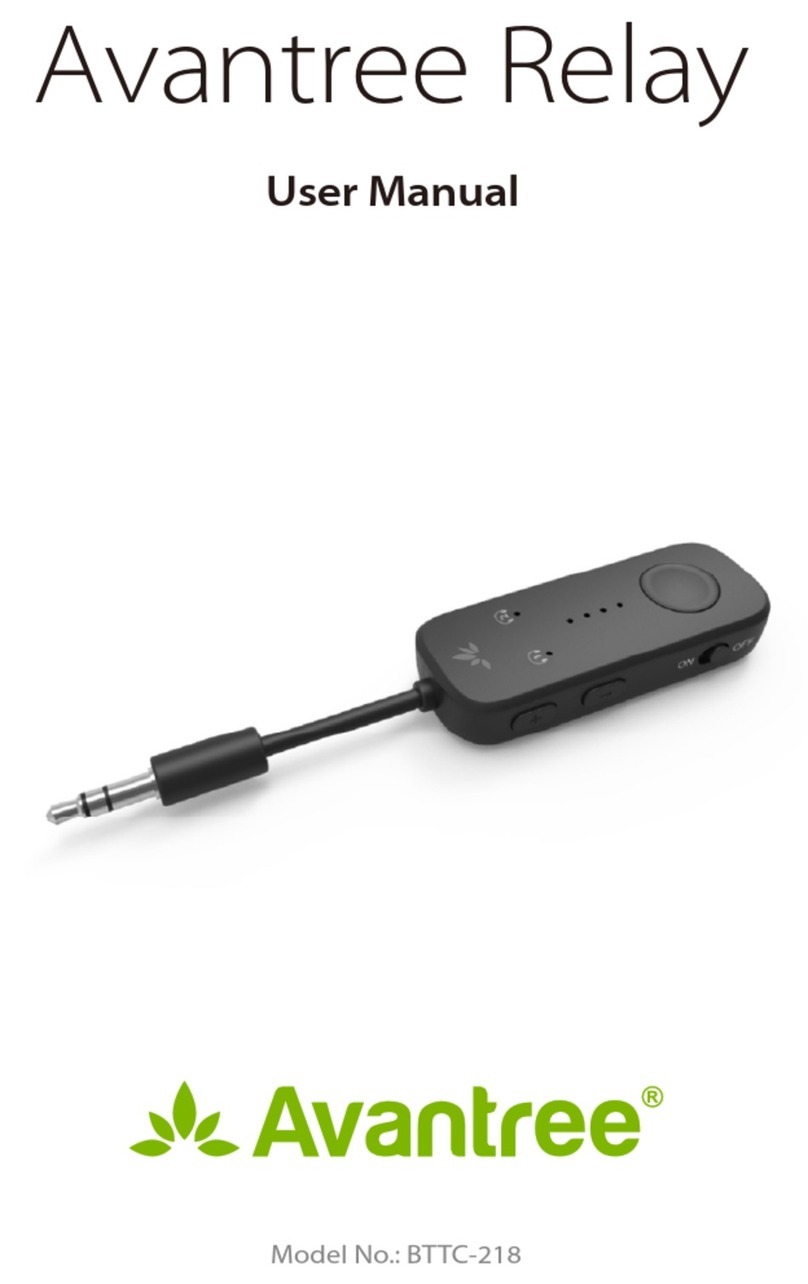
Avantree
Avantree BTTC-218 user manual
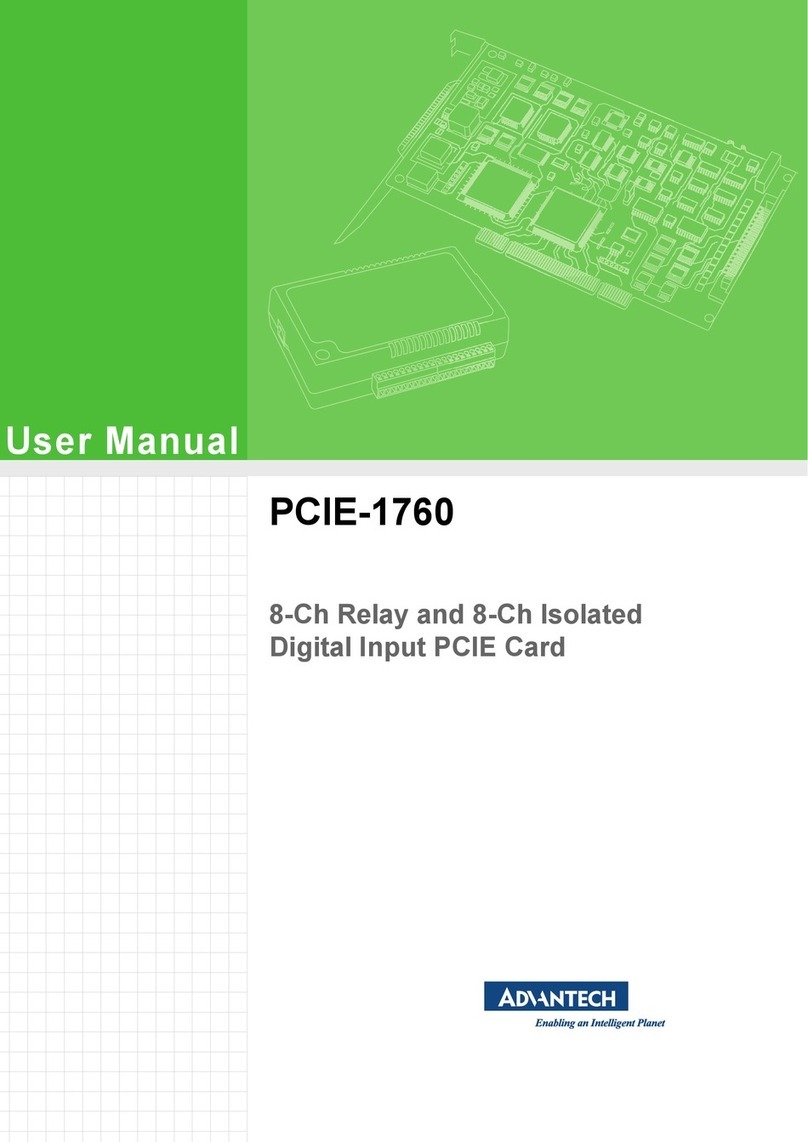
Advantech
Advantech PCIE-1760 user manual
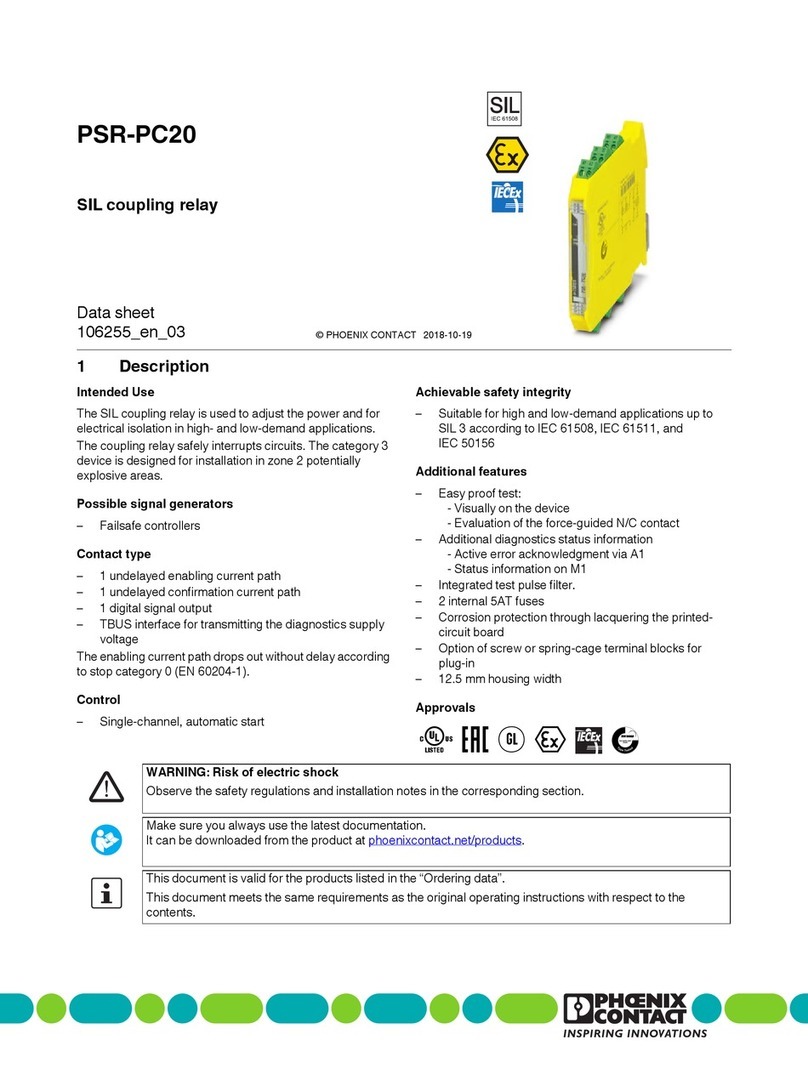
Phoenix Contact
Phoenix Contact PSR-PC20 operating manual

Eaton
Eaton PKZM0-XDM32ME Instruction leaflet
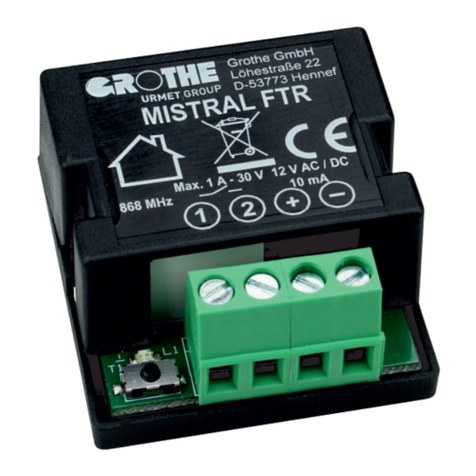
GROTHE
GROTHE MISTRAL FTR Instructions for installation and operation

Catch Power
Catch Power SOLAR RELAY Installation & user guide
